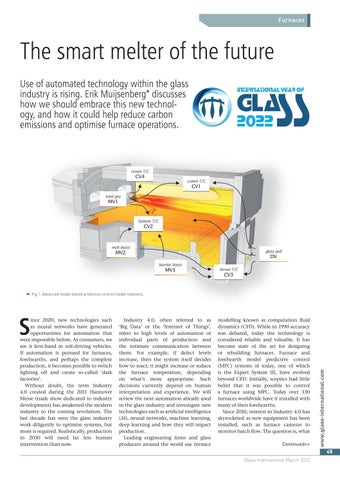Furnaces
The smart melter of the future Use of automated technology within the glass industry is rising. Erik Muijsenberg* discusses how we should embrace this new technology, and how it could help reduce carbon emissions and optimise furnace operations.
S
ince 2020, new technologies such as neural networks have generated opportunities for automation that were impossible before. As consumers, we see it first-hand in self-driving vehicles. If automation is pursued for furnaces, forehearths, and perhaps the complete production, it becomes possible to switch lighting off and create so-called ‘dark factories’. Without doubt, the term Industry 4.0 created during the 2011 Hannover Messe (trade show dedicated to industry development) has awakened the modern industry to the coming revolution. The last decade has seen the glass industry work diligently to optimise systems, but more is required. Realistically, production in 2030 will need far less human intervention than now.
Industry 4.0, often referred to as ‘Big Data’ or the ‘Internet of Things’, refers to high levels of automation of individual parts of production and the intimate communication between them. For example, if defect levels increase, then the system itself decides how to react; it might increase or reduce the furnace temperature, depending on what’s more appropriate. Such decisions currently depend on human interpretation and experience. We will review the next automation already used in the glass industry and investigate new technologies such as artificial intelligence (AI), neural networks, machine learning, deep learning and how they will impact production. Leading engineering firms and glass producers around the world use furnace
modelling known as computation fluid dynamics (CFD). While in 1990 accuracy was debated, today the technology is considered reliable and valuable. It has become state of the art for designing or rebuilding furnaces. Furnace and forehearth model predictive control (MPC) systems of today, one of which is the Expert System III, have evolved beyond CFD. Initially, sceptics had little belief that it was possible to control a furnace using MPC. Today over 330 furnaces worldwide have it installed with many of their forehearths. Since 2010, interest in Industry 4.0 has skyrocketed as new equipment has been installed, such as furnace cameras to monitor batch flow. The question is, what Continued>>
www.glass-international.com
� Fig 1. Advanced model based predictive control model relations.
45 Glass International March 2022
Glass service.indd 1
29/03/2022 10:26:13
